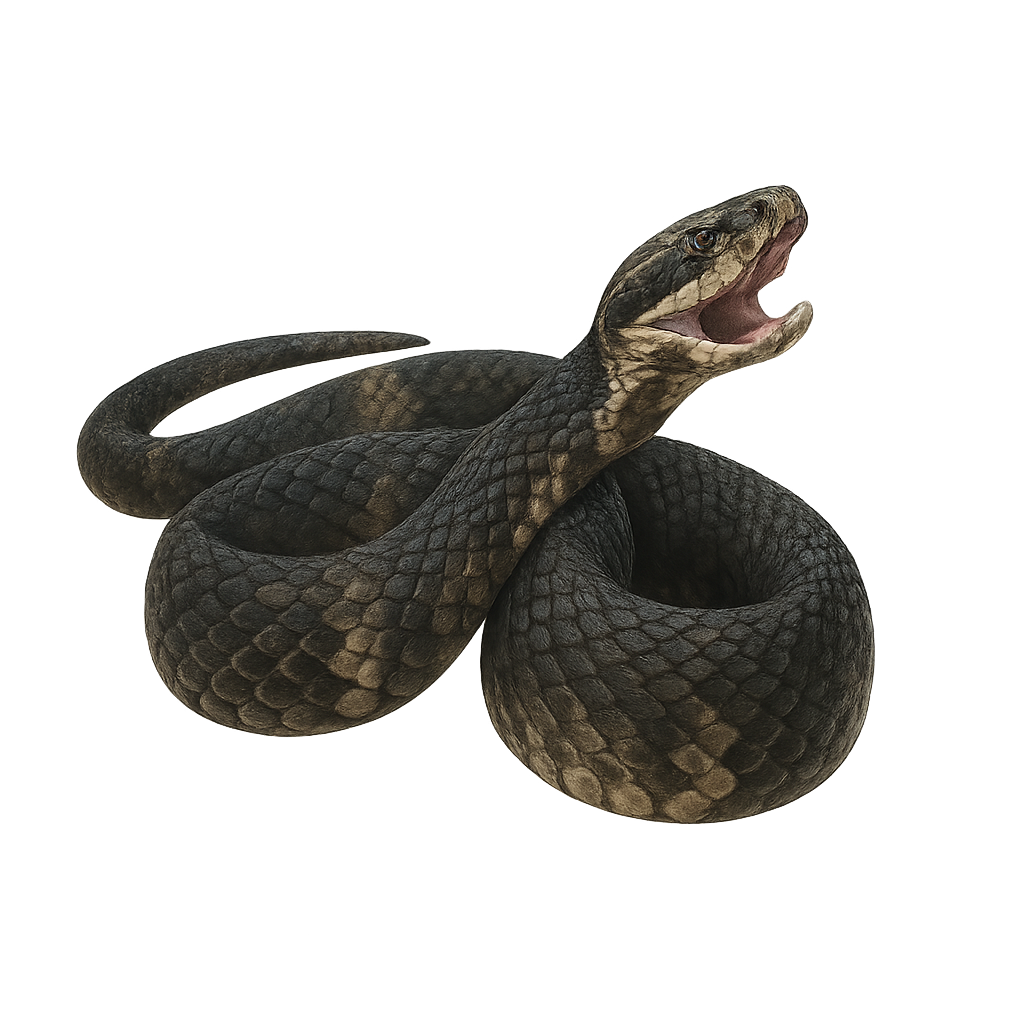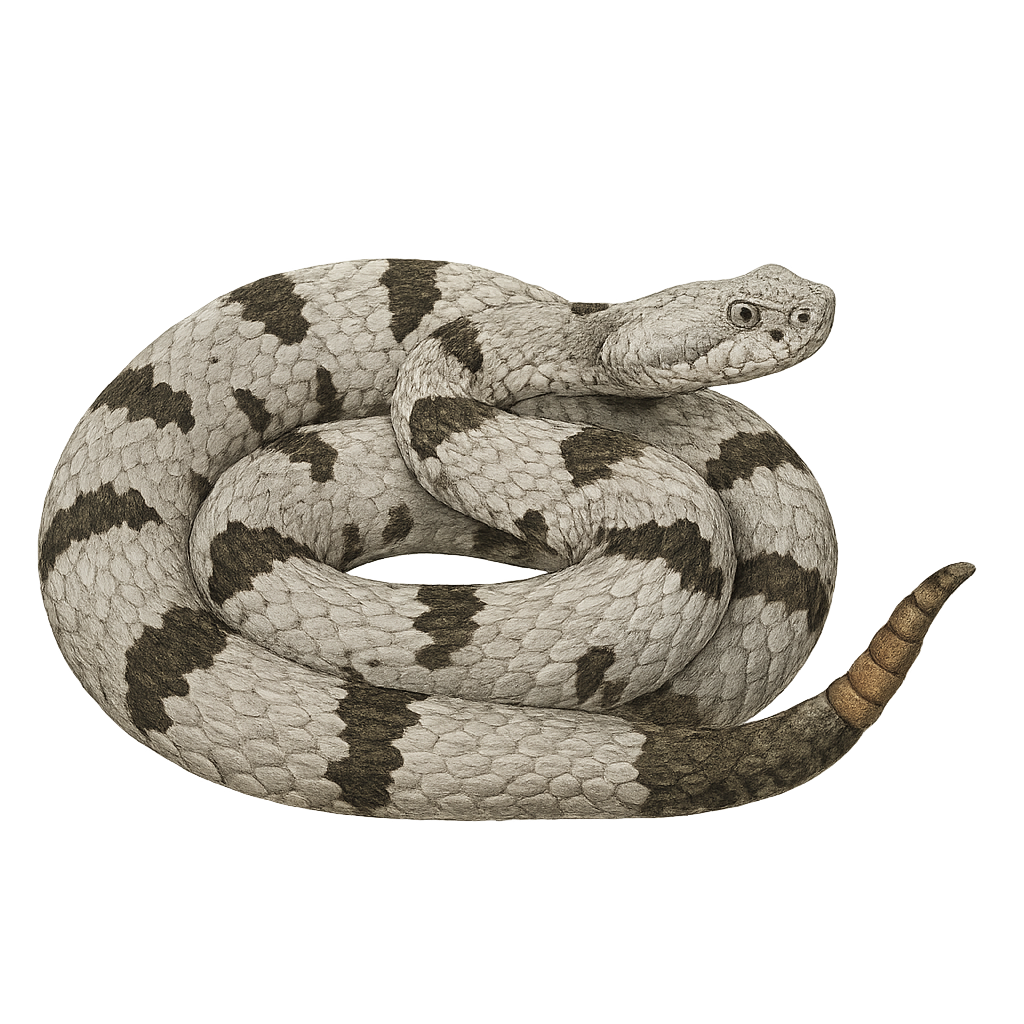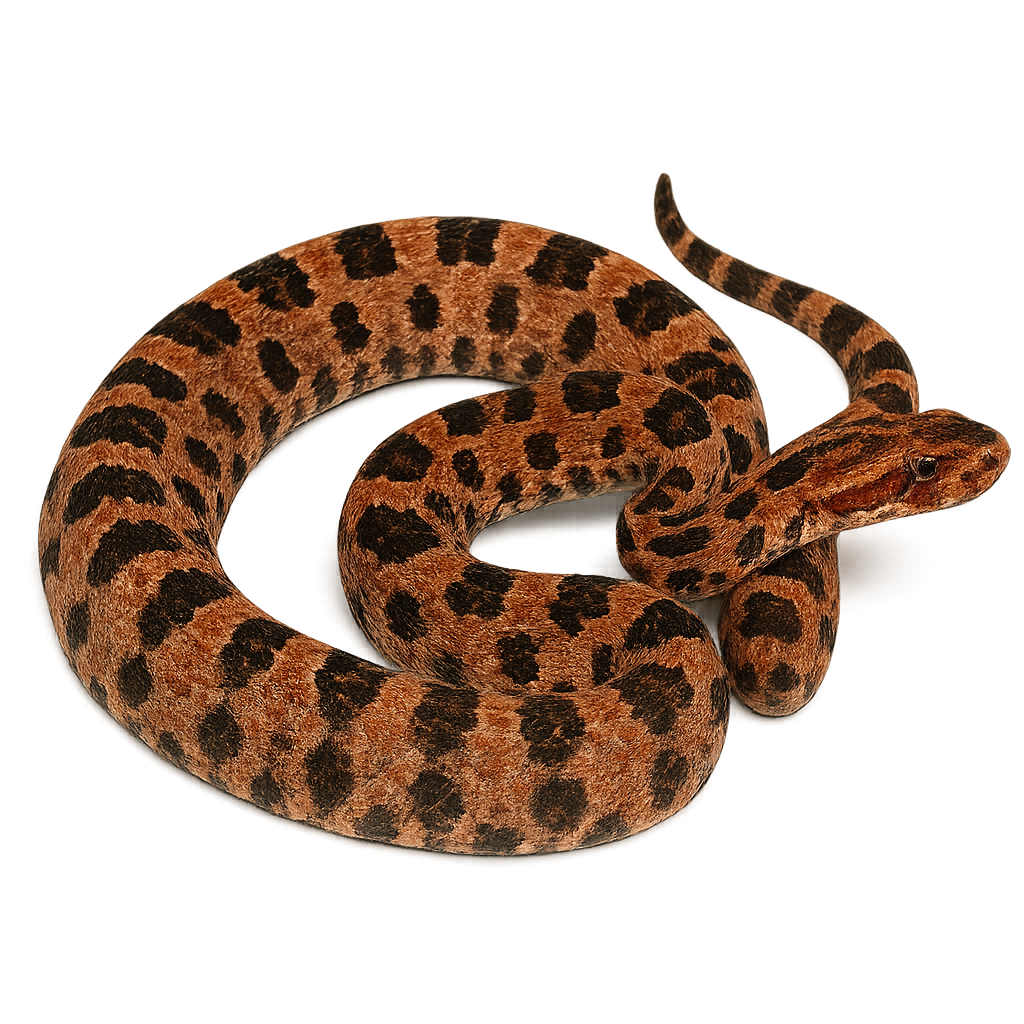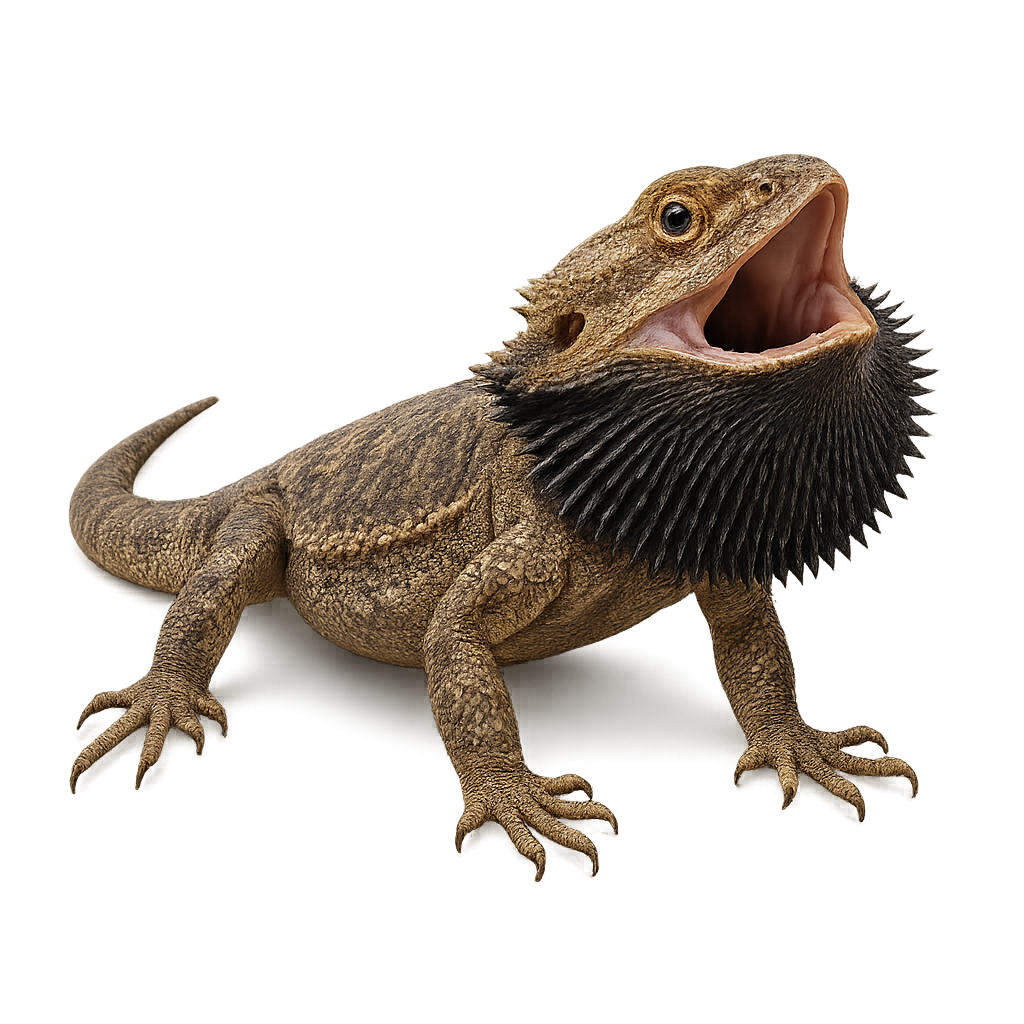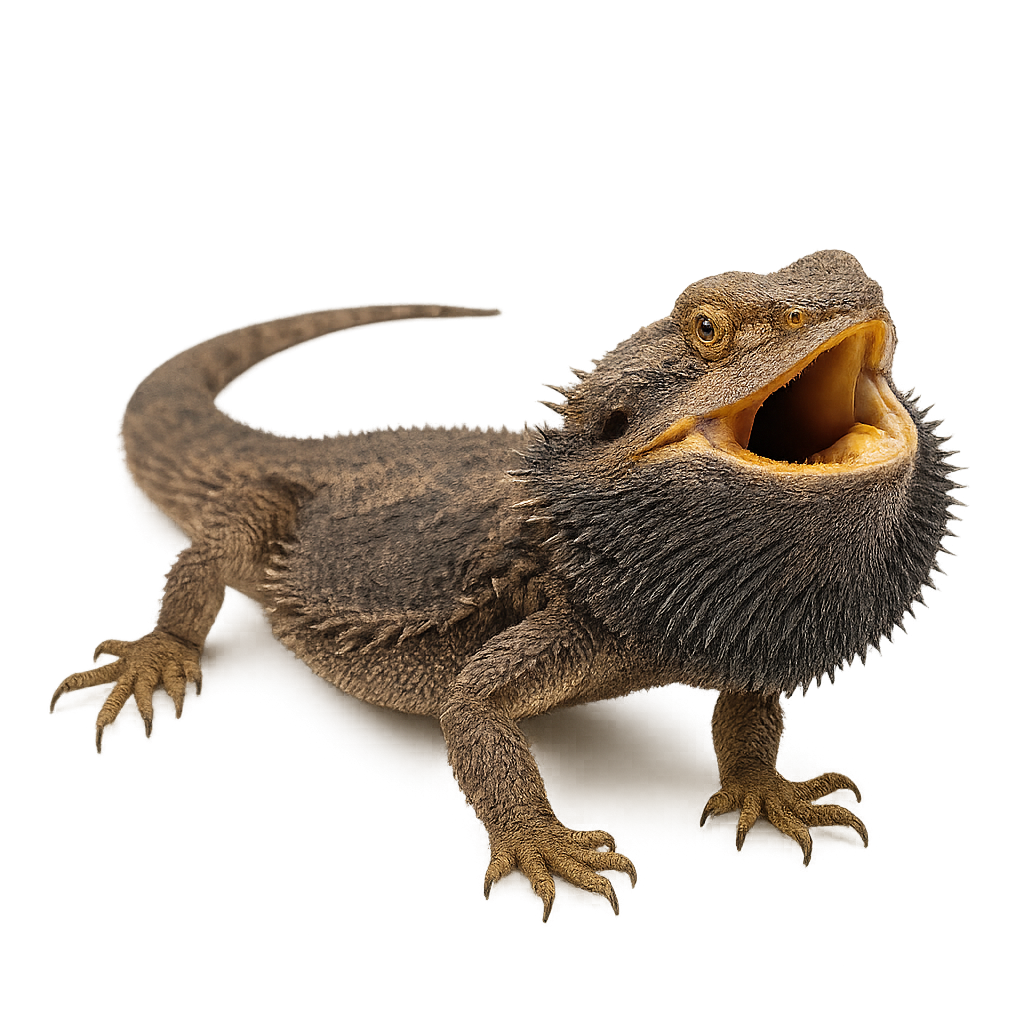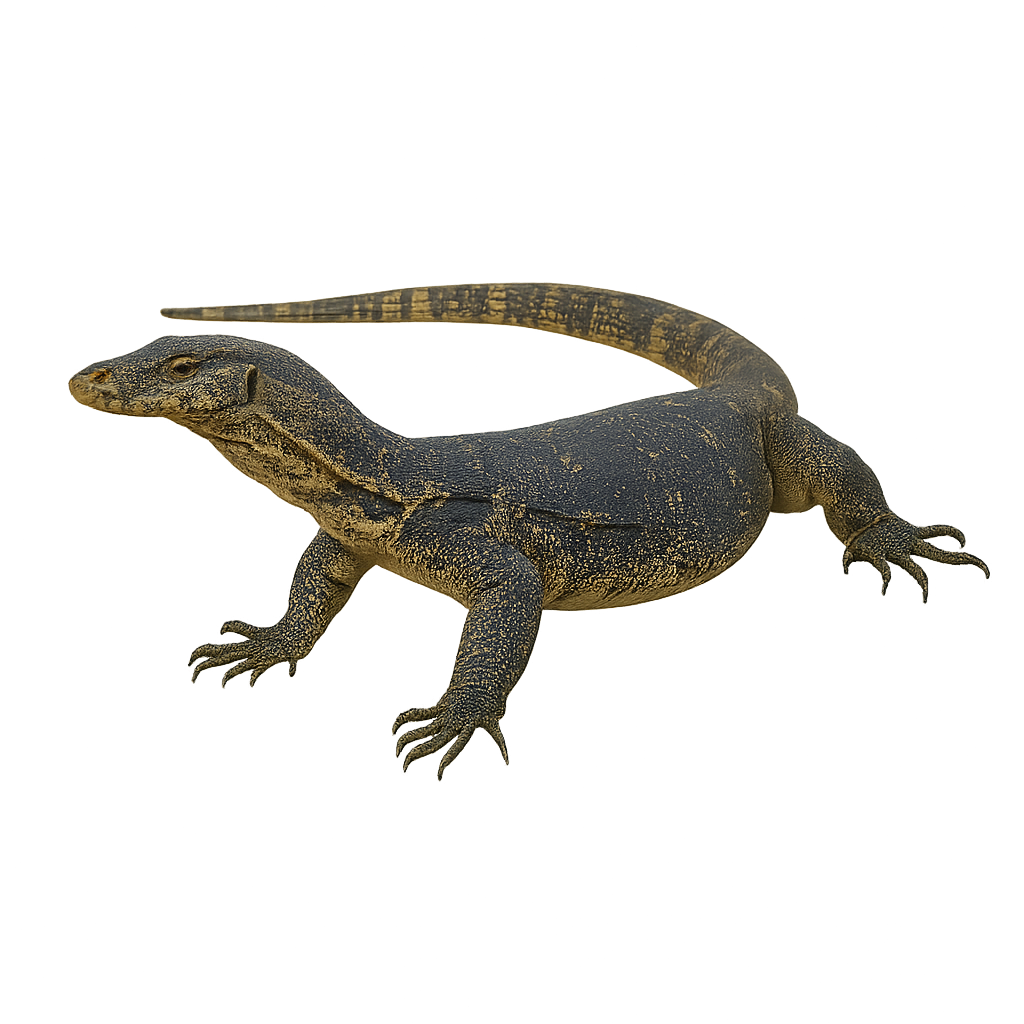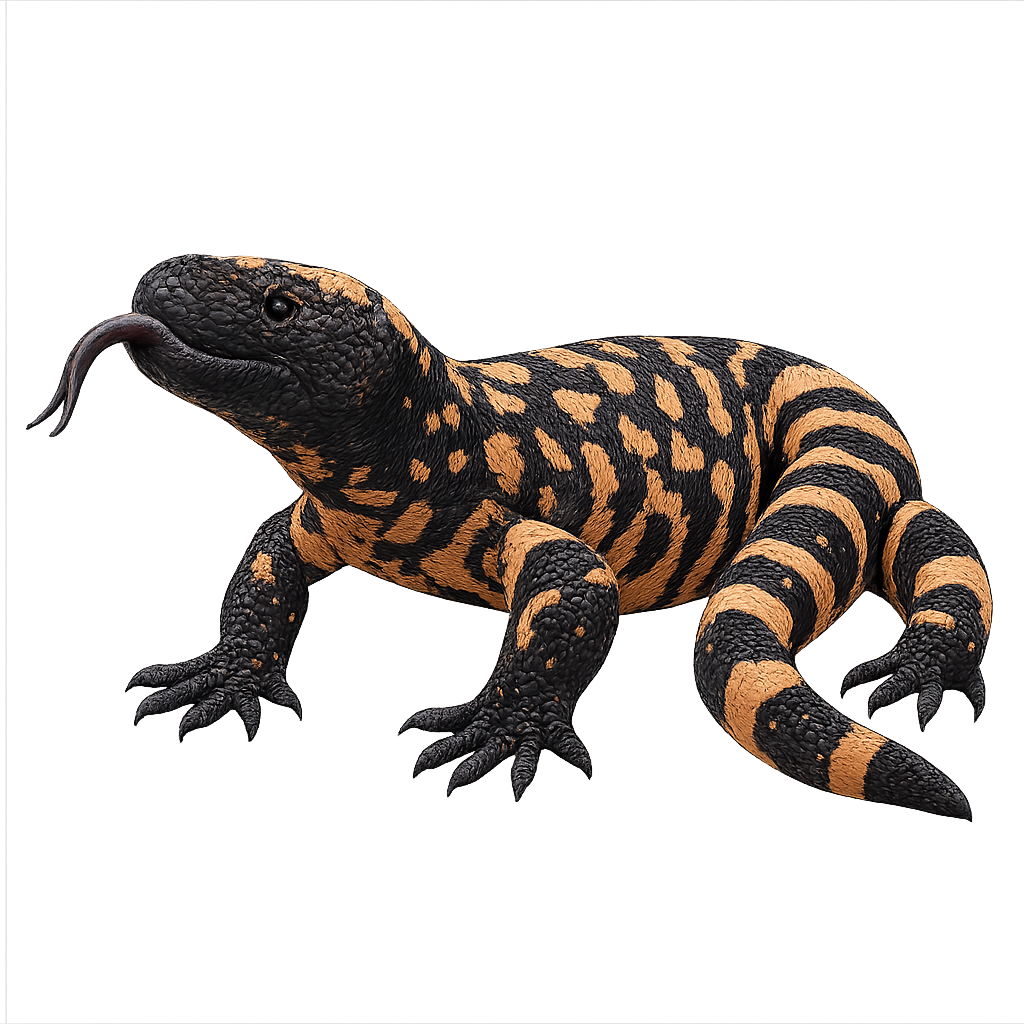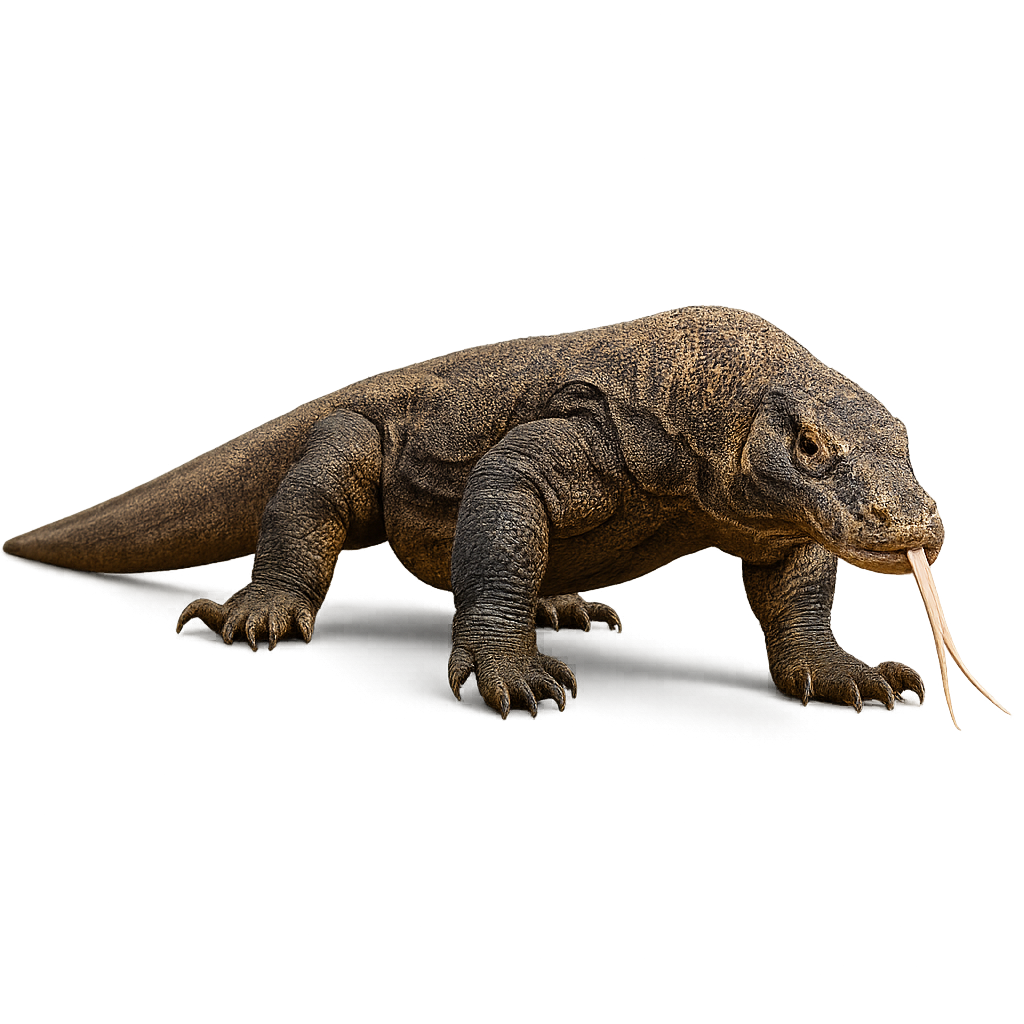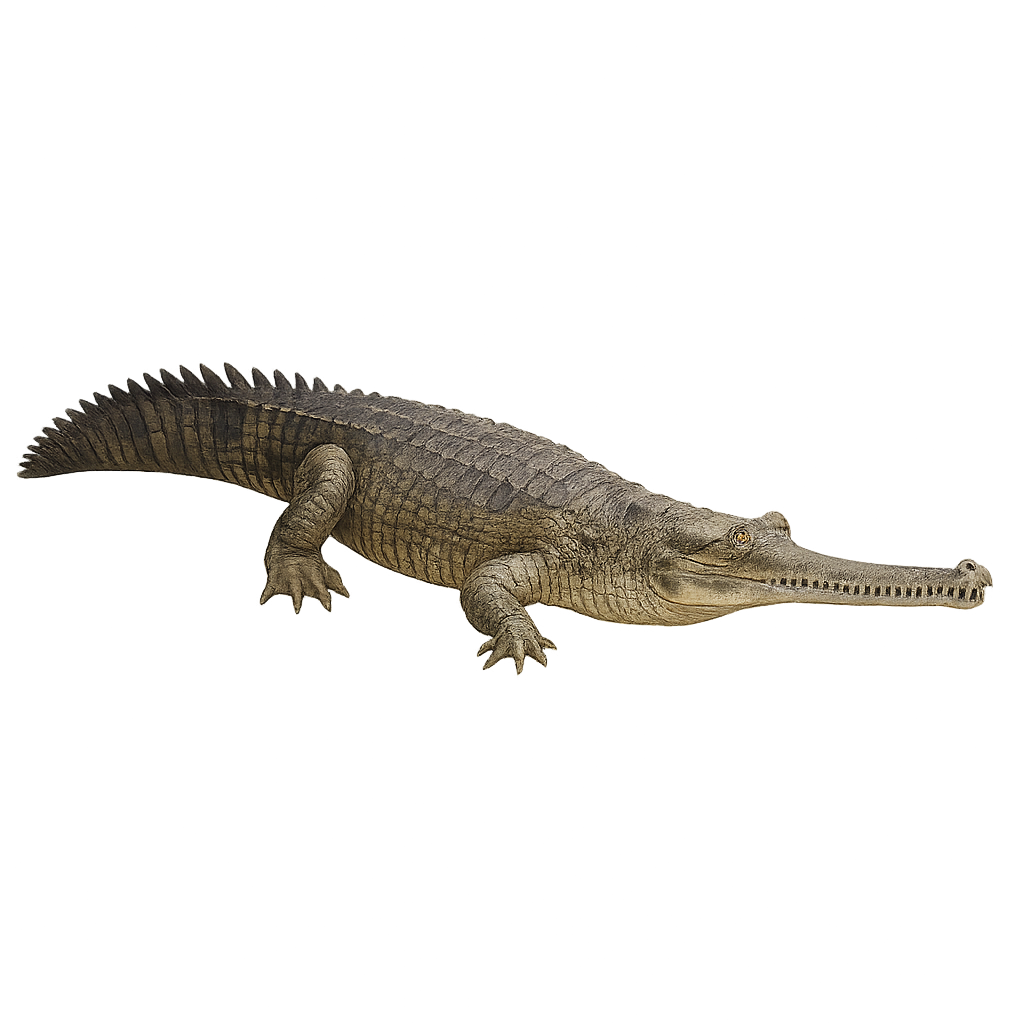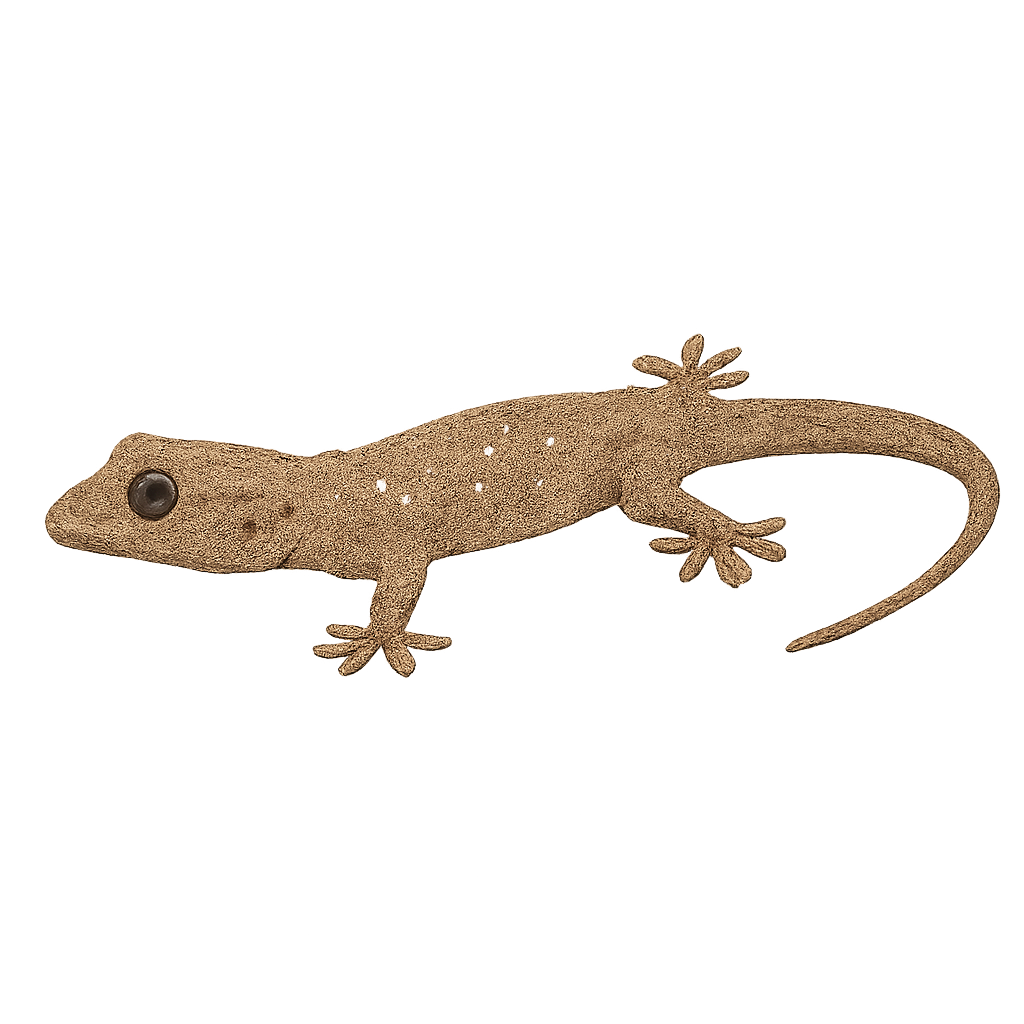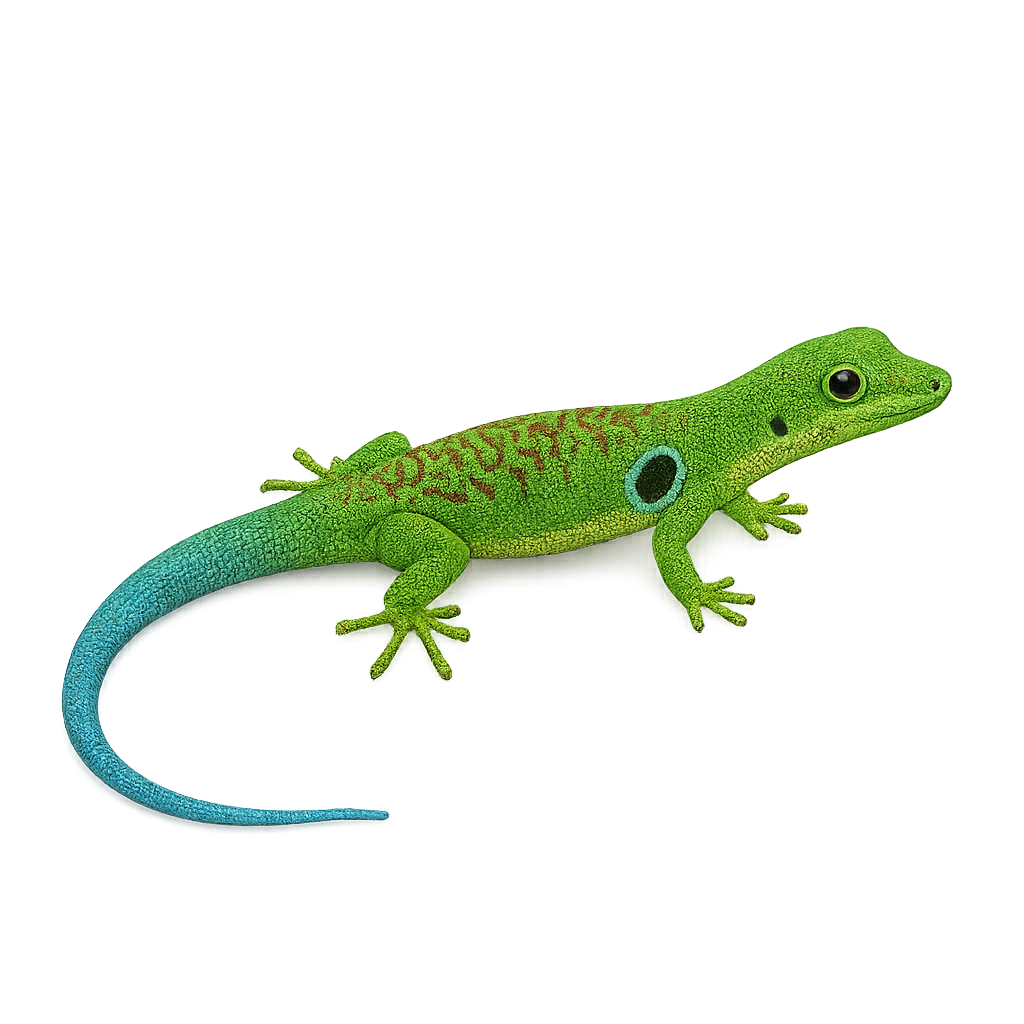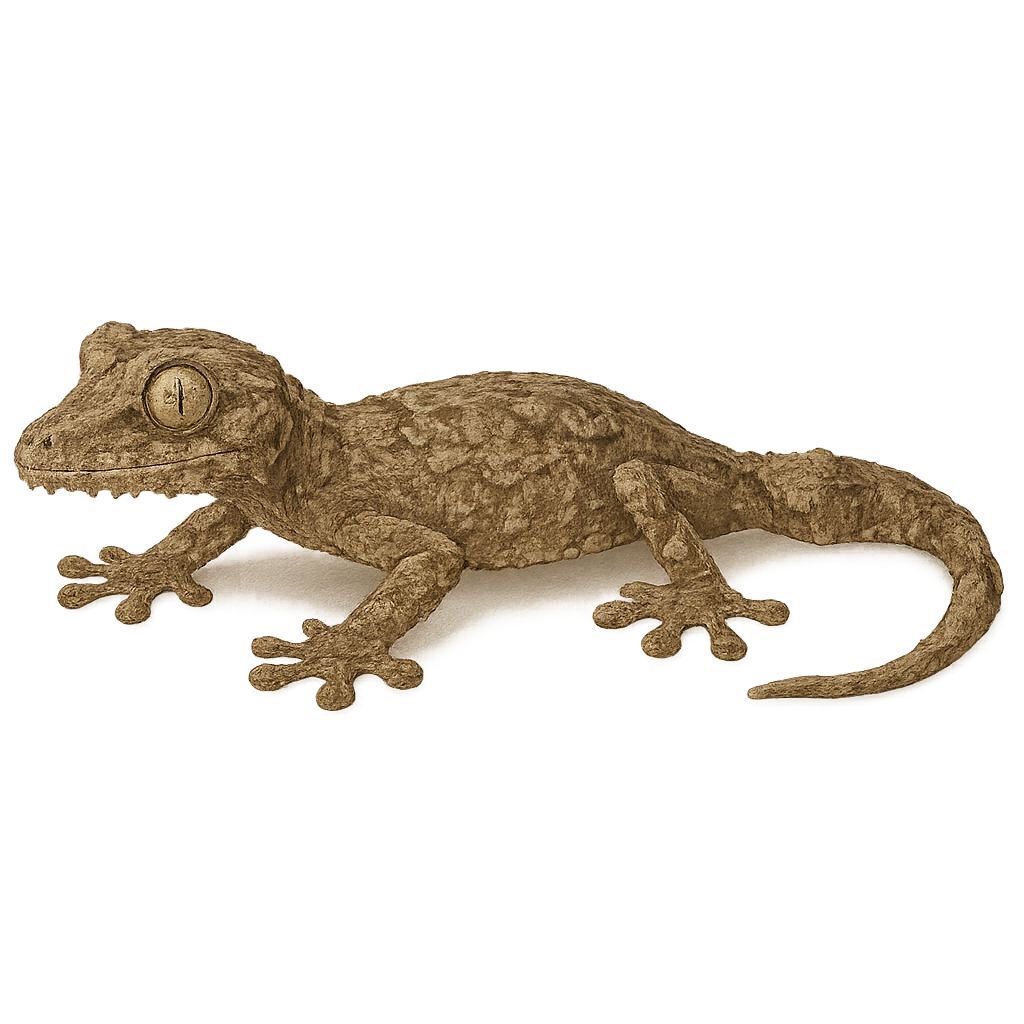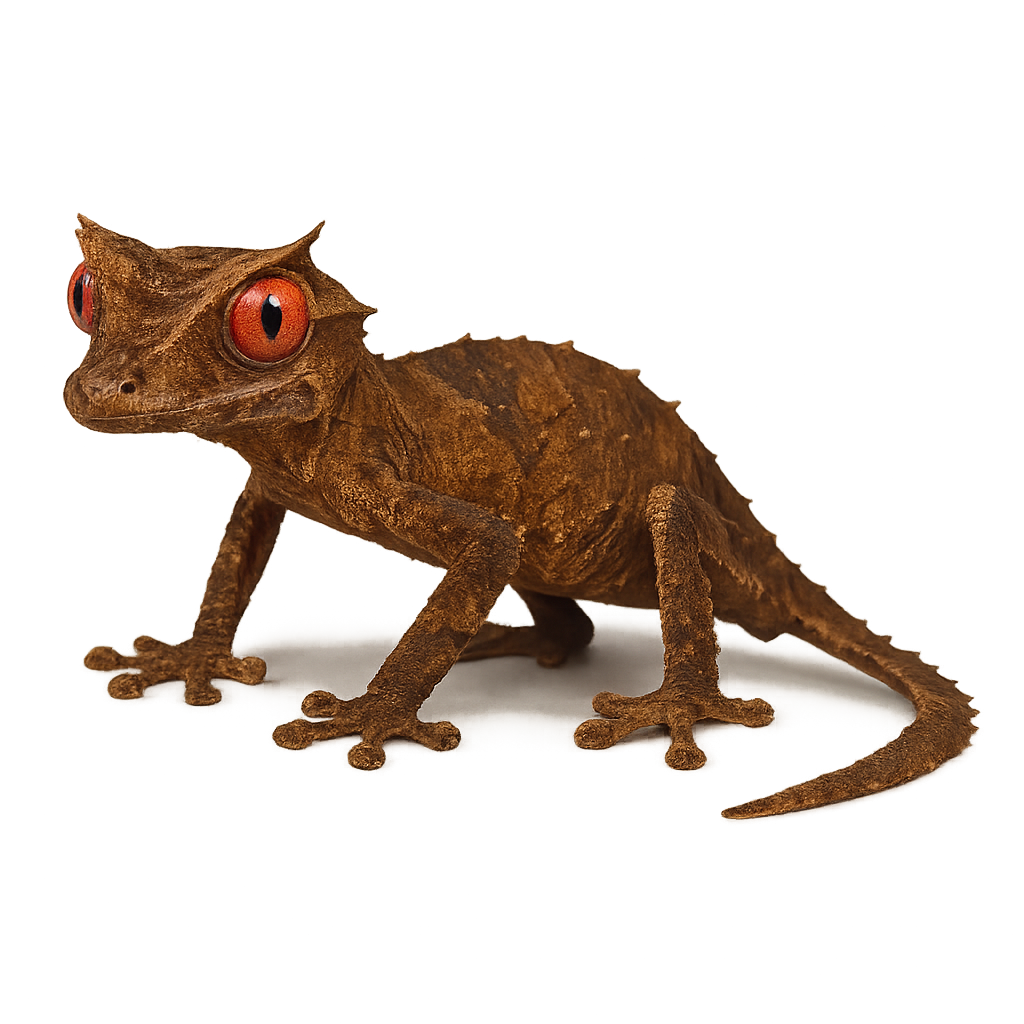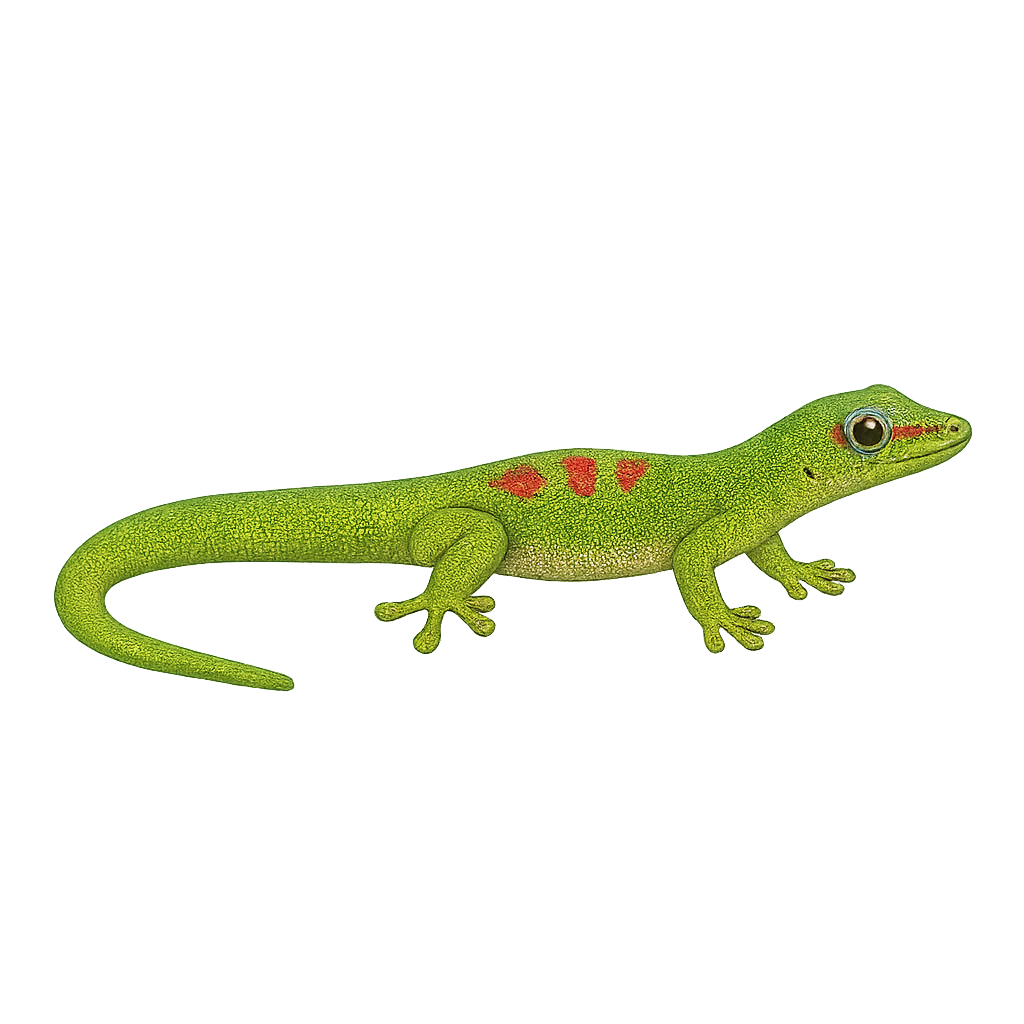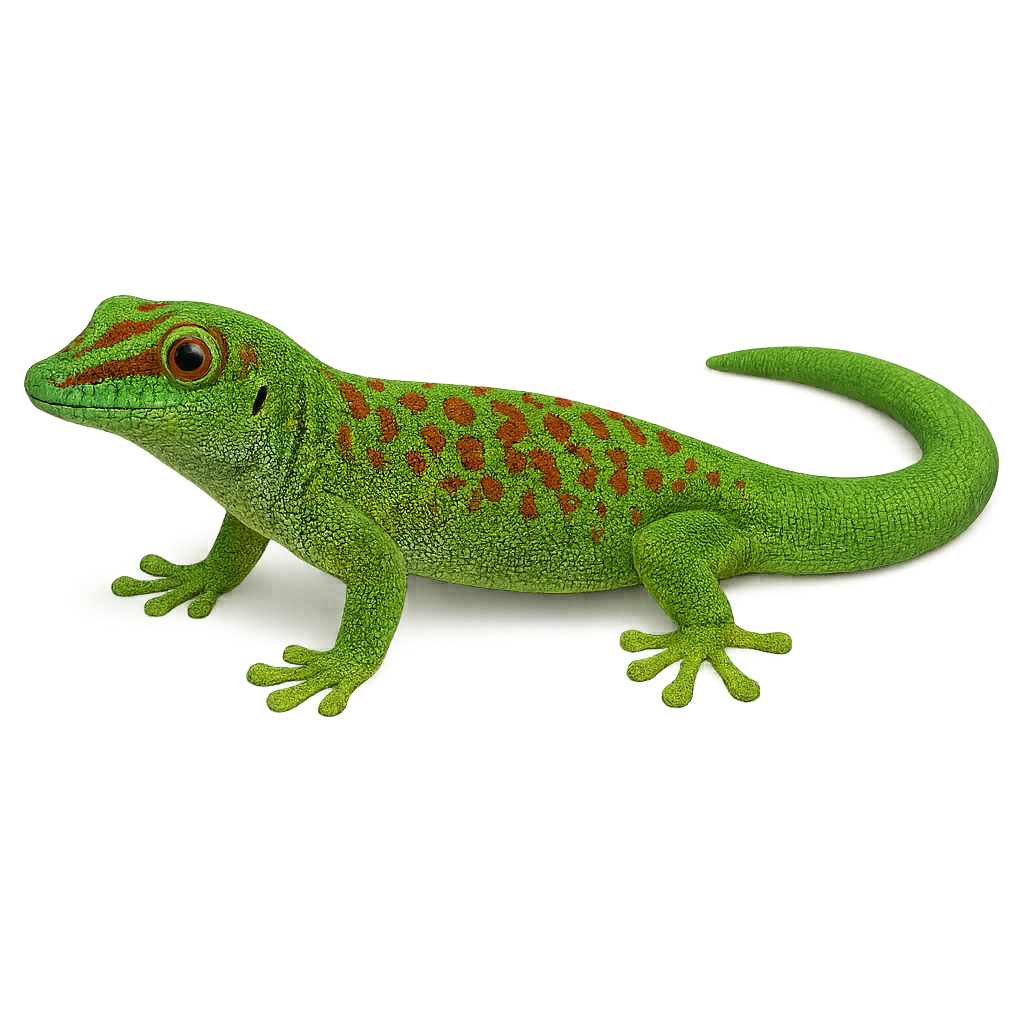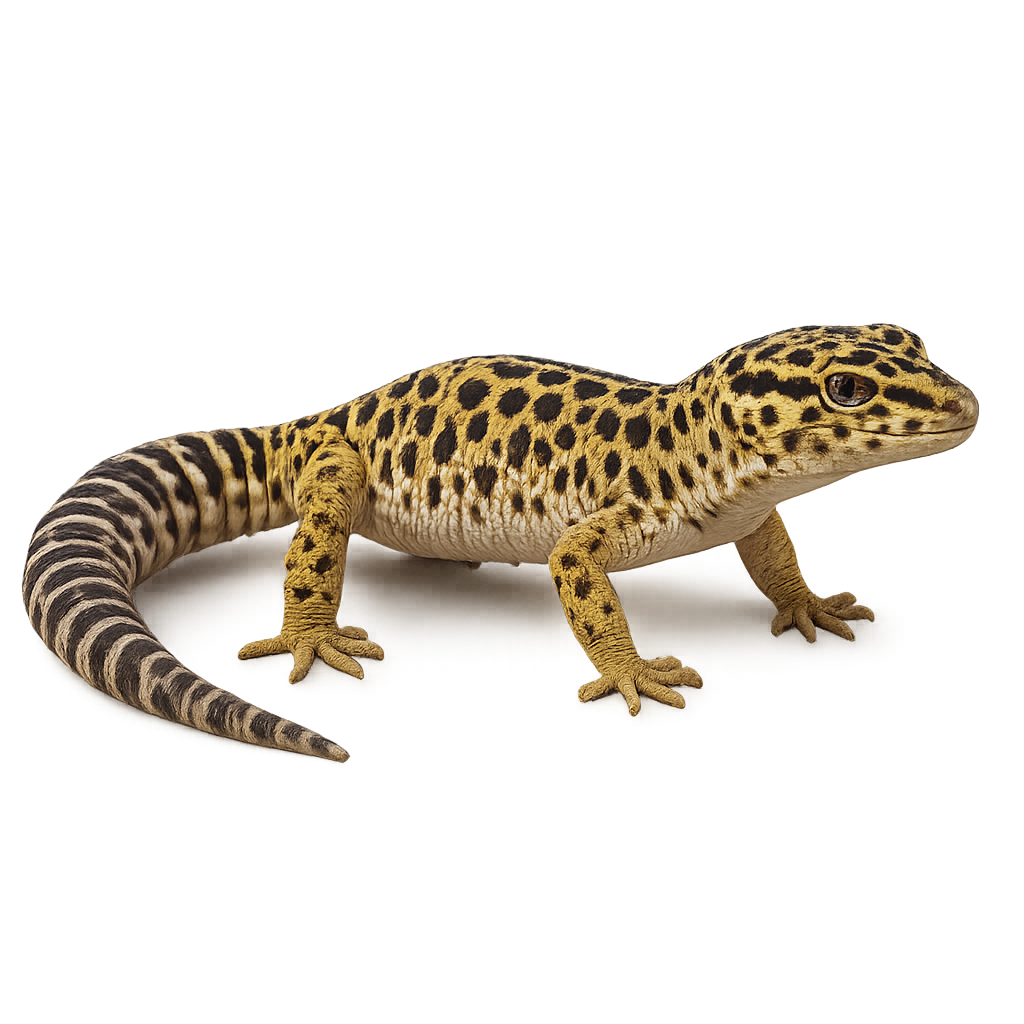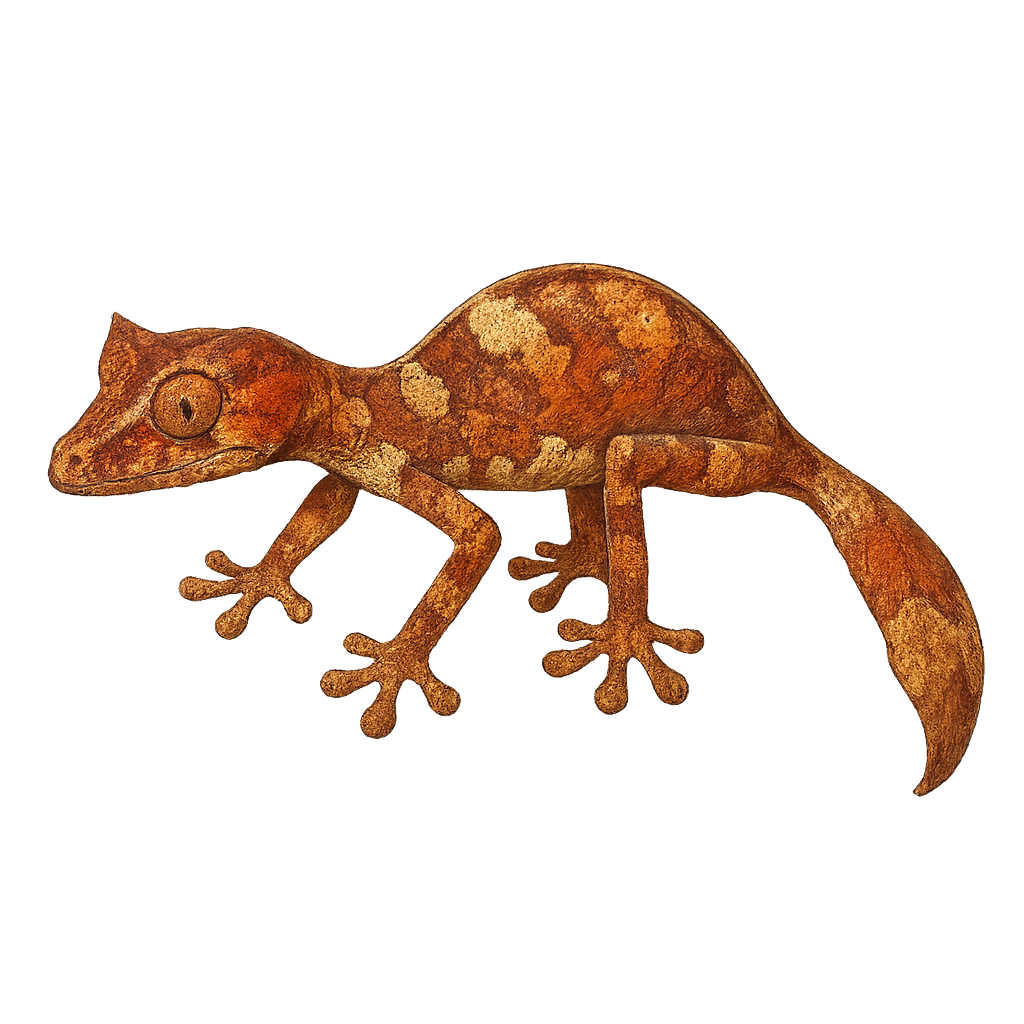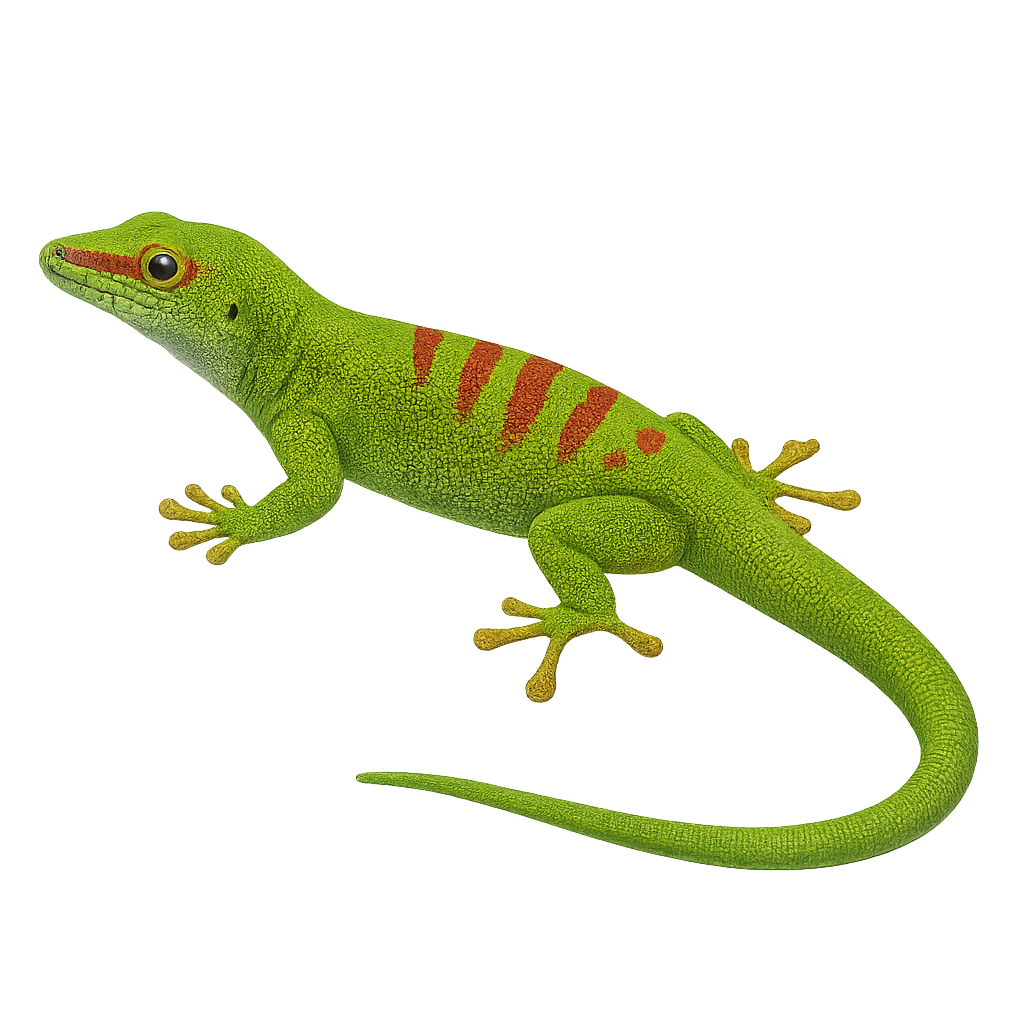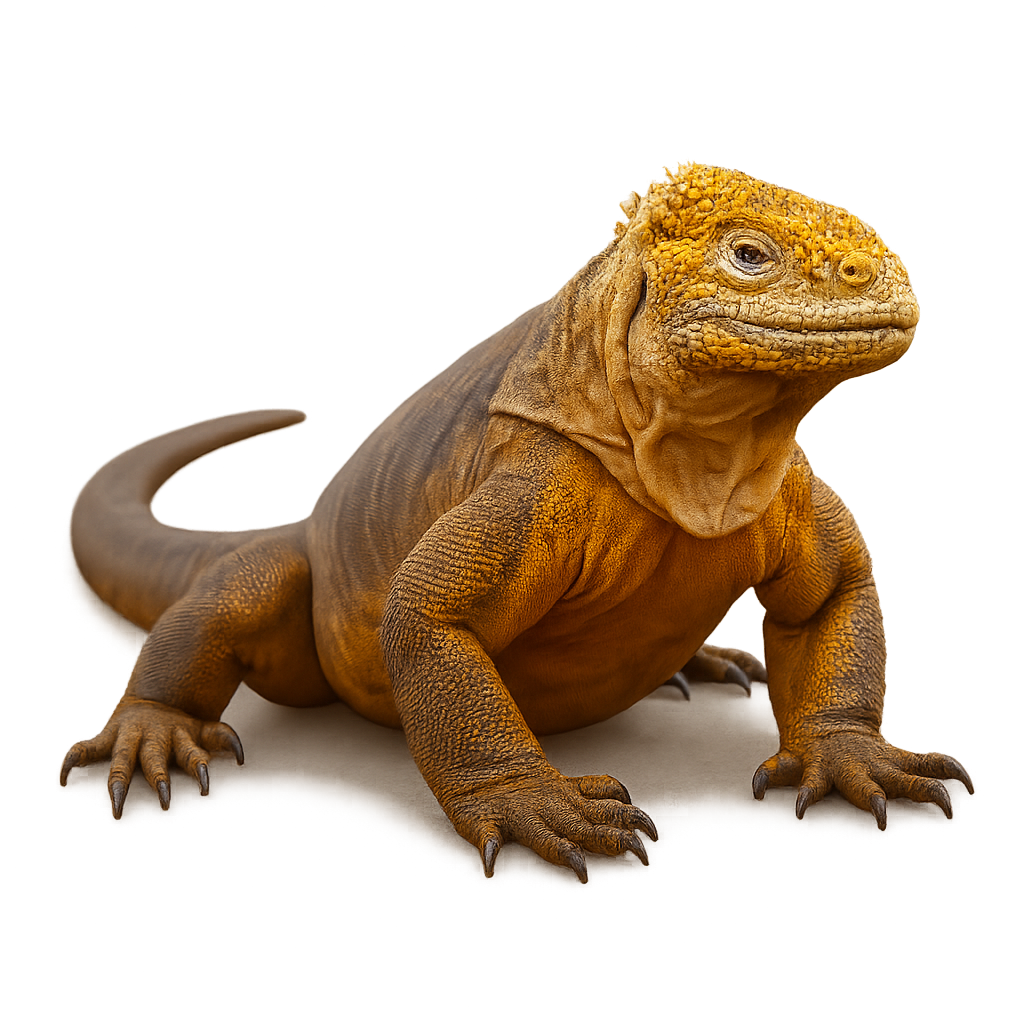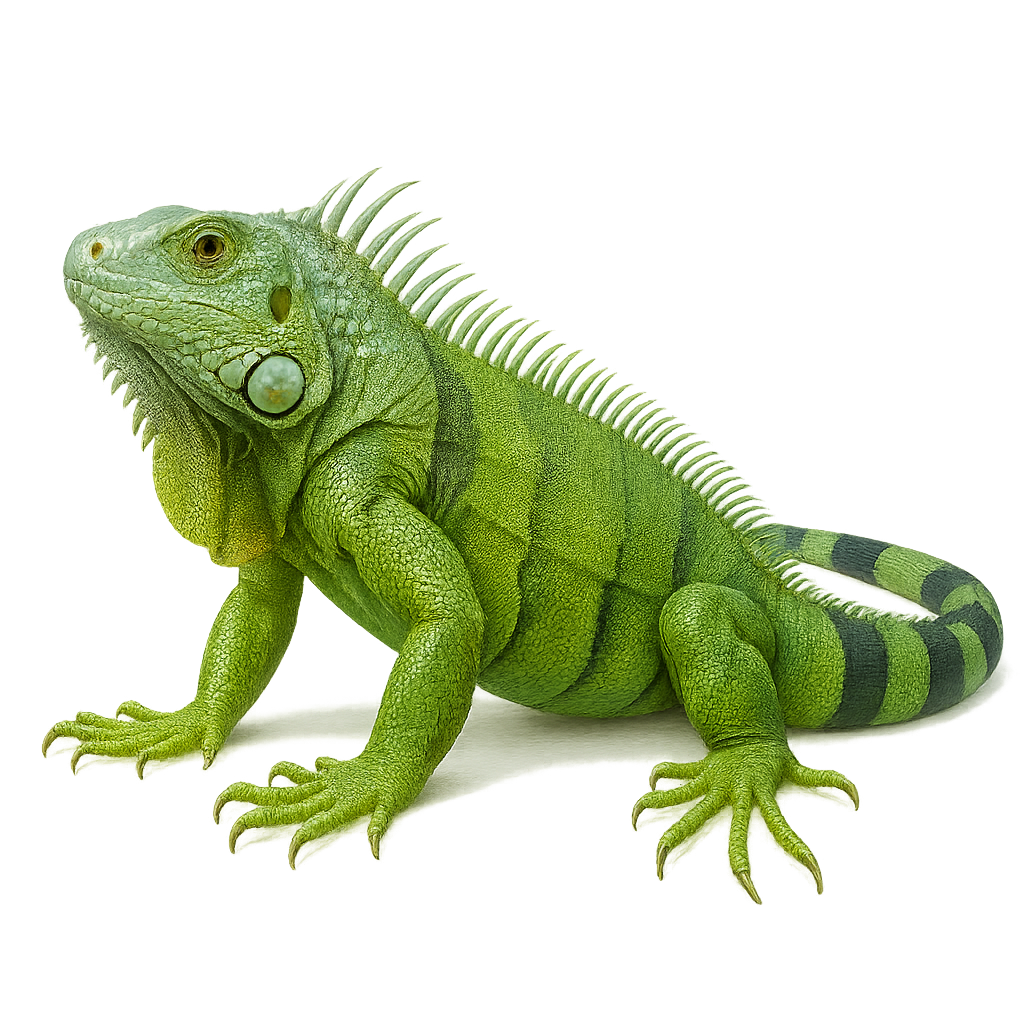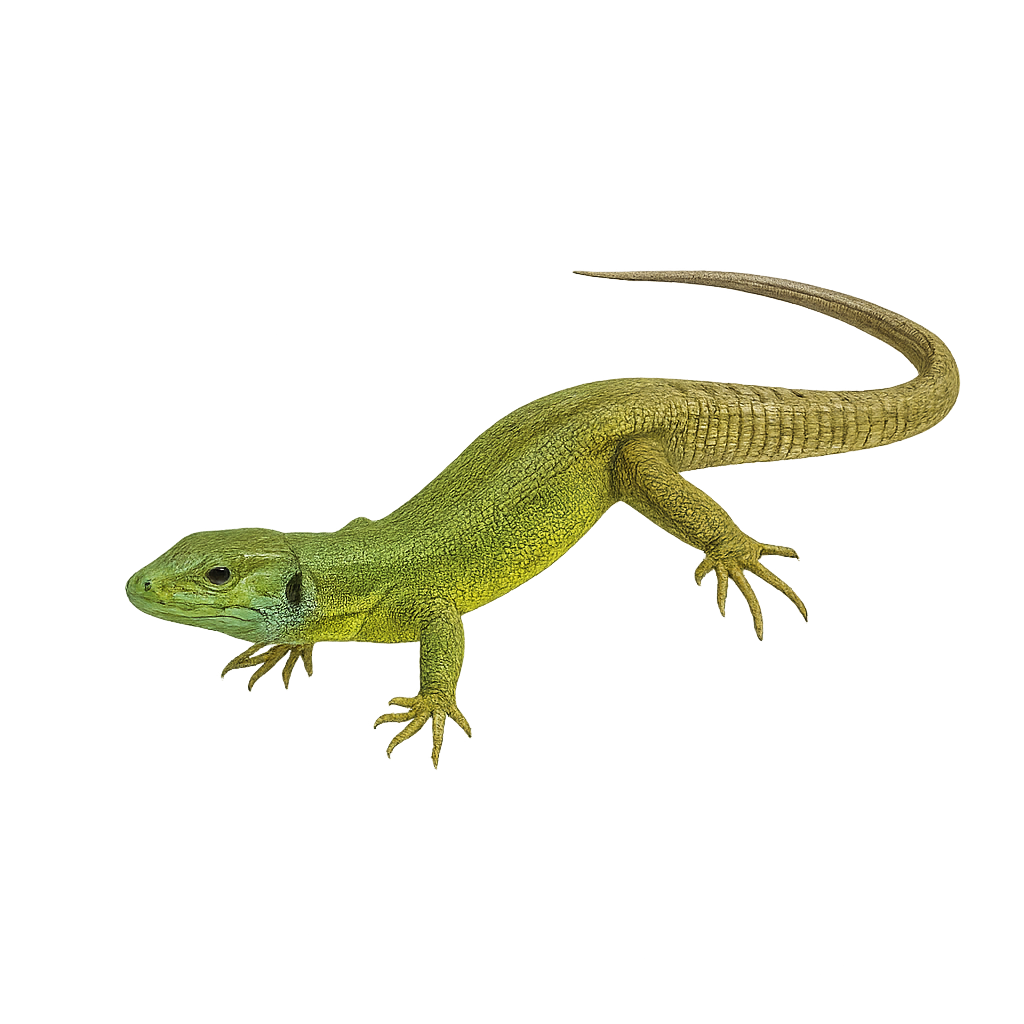The Cottonmouth, or Agkistrodon piscivorus, is a venomous semi-aquatic snake found primarily in the southeastern United States. It is recognizable by its triangular head and coloration that ranges from brown to black, often with lighter crossbands. This snake is well adapted to aquatic environments such as swamps, rivers, and lakes, but can also be found on land. It is known for its defensive behavior, widely opening its mouth to show the white interior, hence the name "cottonmouth". Although venomous, it generally only attacks if it feels threatened. Its bite can be dangerous to humans, requiring immediate medical attention.
The Rock Rattlesnake, or Crotalus lepidus, is a medium-sized venomous snake, typically measuring between 50 and 70 cm in length. It is characterized by its gray or brownish coloration, often marked with dark crossbands, allowing it to blend into its rocky environment. This snake is primarily found in the mountainous regions of the southwestern United States and northern Mexico. It prefers rocky and arid habitats, where it can easily hide. Although venomous, it is generally not aggressive towards humans and prefers to flee rather than bite.
The Sistrurus miliarius, commonly known as the pygmy rattlesnake, is a small venomous snake, typically measuring between 40 and 60 cm. It is recognizable by its varied coloration, ranging from gray to brown, with diamond-shaped or banded patterns. Its head is triangular, and it has a small rattle at the end of its tail, although this is often less noisy than that of other rattlesnakes. It is primarily found in the southeastern United States, inhabiting diverse environments such as pine forests, marshes, and grasslands. Although venomous, its bites are rarely fatal to humans but still require immediate medical attention.
The Thorny devil is a fascinating lizard native to the deserts of Australia. Its skin is covered with sharp spines that allow it to camouflage effectively among rocks and desert vegetation. It primarily feeds on ants, which it captures using its sticky tongue. When threatened, it adopts a defensive posture, inflating its body and displaying its spines to appear larger and more threatening. While calm, it is an expert in the art of camouflage and uses its appearance to protect itself from predators.
The bearded dragon (Pogona vitticeps) is a medium-sized diurnal lizard (20–60 cm total length, including tail) with a broad triangular head and spiny scales around its throat. Native to central Australia’s arid regions, it inhabits savannas, rocky outcrops and semi-desert areas, feeding on insects, small vertebrates and plant matter. During the breeding season (September 1–February 28), males bob their beards and perform lateral shuffles to court females, which lay clutches of 15–30 eggs buried in sand. Hatchlings emerge between November 15 and April 15 after a 60–75-day incubation.
The Pogona barbata, commonly known as the Eastern Bearded Dragon, is a lizard native to Australia. It is recognizable by its "beard" of spines under the throat, which it can inflate to ward off predators or rivals. This diurnal reptile is often found in open forests, grasslands, and shrublands. It can reach a length of 60 cm, including the tail. Its diet is omnivorous, consisting of insects, small animals, and vegetation. The Pogona barbata is popular as a pet due to its generally docile nature and adaptability to captivity.
The Asian water monitor is a large lizard belonging to the monitor family. It is widely distributed across Southeast Asia and primarily inhabits wetland areas, particularly near rivers, swamps, and lakes. A carnivore, it feeds mainly on fish, amphibians, small mammals, and insects. Capable of swimming and climbing with agility, it is an excellent predator. While not considered threatened, it faces threats due to habitat loss and hunting.
This semi-aquatic varanid lizard can reach 1.2 m in length, with a robust dark brown body marked by yellow crossbars. It inhabits humid forests and mangrove swamps of Southeast Asia, feeding mainly on crabs, molluscs and small vertebrates. During breeding, females dig burrows to lay clutches of 4–23 eggs.
The Gila monster is a large venomous lizard, reaching 30–56 cm in length, with a robust body and bead-like scales patterned in yellow, pink, and black. Native to the deserts of the Southwestern United States and northern Mexico, it inhabits scrubland, succulent desert, and oak woodland, feeding mainly on small mammals, birds, and eggs. As the breeding season (April to June) approaches, males become territorial and exhibit dominance displays by lifting their bodies and bobbing their heads before mating.
The Komodo Dragon is a large carnivorous lizard, famous for its impressive size and strength. It typically measures between 2 and 3 meters in length and can weigh up to 70 kg. Its massive body is covered with scales, usually grayish-green, which helps it blend into its natural environment. The Komodo Dragon is found exclusively on a few islands in Indonesia, including Komodo, Rinca, Flores, and Gili Motang. This apex predator feeds on a variety of animals, from birds to mammals like deer, as well as carrion. It primarily hunts using its developed sense of smell, able to detect odors from several kilometers away. Due to its powerful bite and saliva filled with bacteria, the Komodo Dragon can incapacitate its prey and wait for it to succumb to infection before feeding. The species is listed as vulnerable, threatened by habitat loss, illegal hunting, and excessive tourism. Conservation efforts are in place to protect this unique creature and its habitat.
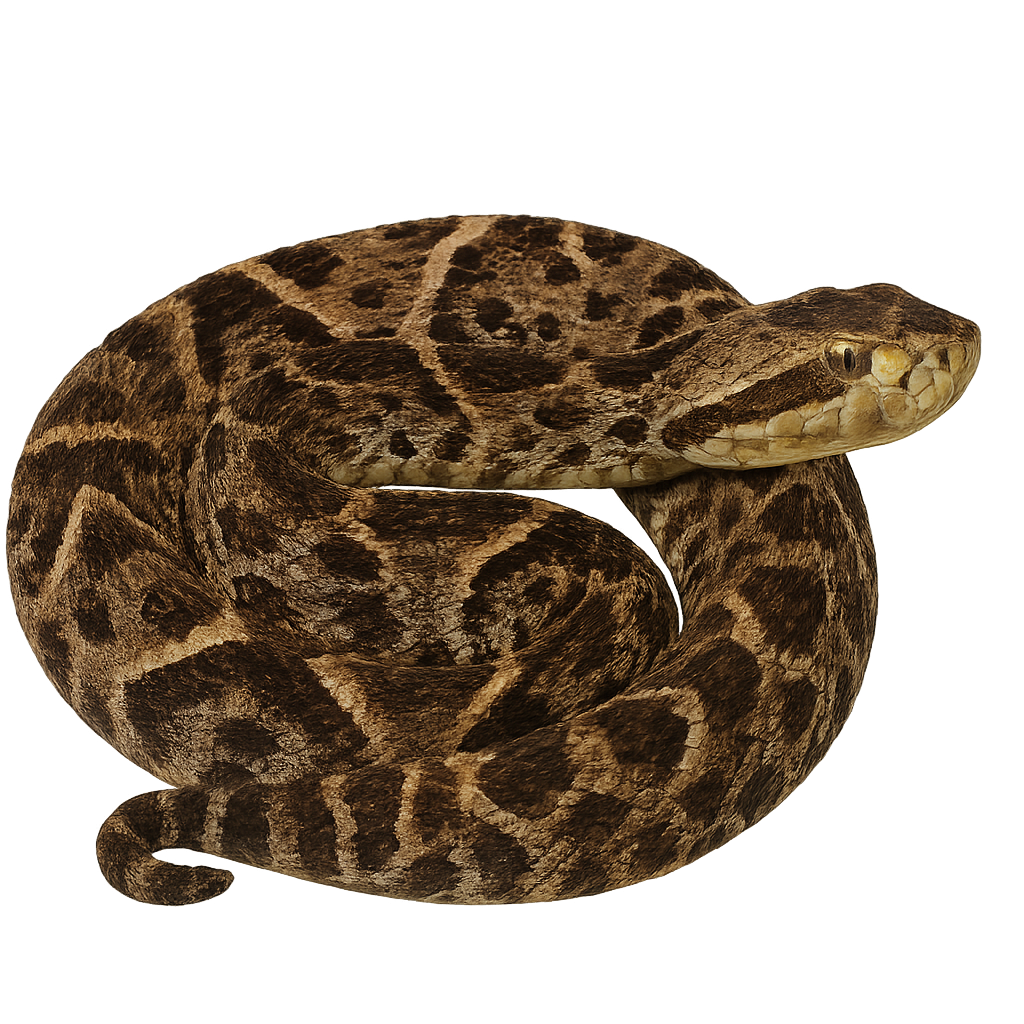
The Barba amarilla is a venomous viper found primarily in the rainforests of Central and South America. It is a medium to large snake, typically measuring between 1.5 and 2.5 meters in length, although some individuals can reach up to 3 meters. Its body is robust, and its color ranges from brown, gray, to olive, with diamond-shaped patterns along its back, which helps it blend into its environment. Its head is triangular and distinct from the body, with characteristic scales that give it a "spearhead" appearance. This snake is primarily terrestrial and often hides under leaves or in underbrush to hunt or rest. The Barba amarilla is an opportunistic predator, feeding mainly on small mammals, birds, and frogs. Its venom is extremely potent and can cause severe injury or death if antivenom is not administered quickly. It usually strikes by surprise, launching itself at its prey or an intruder. While it is an important predator in its ecosystem, it faces threats related to deforestation and habitat loss.
The Ganges gavial is a distinctive crocodilian, easily recognized by its long, narrow snout that allows it to capture fish in the rivers of the Indian subcontinent. This aquatic reptile is primarily found in the rivers of the Ganges and its tributaries in India and Nepal. The Ganges gavial is an excellent swimmer and feeds almost exclusively on fish, which it captures using its long, slender snout like a pincer. Although relatively calm, it is listed as endangered due to habitat loss and river pollution. It is currently protected by conservation programs.
The Smith's green-eyed gecko (Gekko smithii) is a medium-sized nocturnal lizard (total length up to 35 cm, SVL 19 cm) with olive-green to brown mottled dorsal coloration and a pale throat bordered by dark mottling. Endemic to tropical and secondary forests of Southeast Asia (Thailand, Malaysia, Indonesia, Myanmar, Singapore), it occupies tree trunks and riparian vegetation where it forages for insects and arachnids. Reproduction occurs year-round, with females laying clutches of two eggs followed by an incubation period of 60–90 days. It uses crevices for shelter, produces harsh calls to communicate, and exhibits moderate wariness.
The Phelsuma quadriocellata, or four-spotted day gecko, is a small, colorful lizard native to Madagascar. It is known for its bright green skin adorned with blue and red spots, and its distinctive four black spots on the back. This diurnal gecko is often found in humid tropical forests, feeding mainly on insects and nectar. It is appreciated for its adaptability to various environments, including gardens and human dwellings. Although generally suspicious, it can become tolerant of humans over time. Its reproduction is oviparous, with a gestation period of about 40 to 45 days.
The Sikora's Leaf-tailed Gecko, Uroplatus sikorae, is a master of disguise, blending seamlessly into its surroundings with skin that mimics tree bark. Native to Madagascar, it primarily inhabits humid tropical forests. This nocturnal reptile is known for its ability to remain motionless for extended periods, making it difficult to spot. Its leaf-shaped tail is not only a tool for camouflage but also a means of communication with its peers. Measuring between 15 and 20 cm, it primarily feeds on insects. Although its appearance is striking, it is harmless to humans.
The Uroplatus ebenaui is a fascinating gecko endemic to Madagascar, renowned for its exceptional ability to blend into its surroundings. Its brown coloration and flattened shape allow it to resemble a dead leaf, providing perfect camouflage against predators. Measuring about 10 cm in length, it has a leaf-shaped tail that enhances its mimicry. This nocturnal gecko is primarily arboreal, inhabiting humid tropical forests. It feeds on insects and other small invertebrates. Its reproduction is oviparous, with eggs laid in the forest litter. Although discreet, it plays a crucial role in the ecosystem by regulating insect populations.
The Phelsuma laticauda, commonly known as the gold dust day gecko, is a small, brightly colored lizard native to Madagascar and nearby islands. It is easily recognizable by its vibrant green color, often adorned with golden or red spots on its back. Its size typically ranges from 10 to 15 cm, including the tail. This gecko is diurnal, meaning it is active during the day, and is often seen on tree trunks or the walls of human dwellings. It primarily feeds on insects but also enjoys nectar and fruits. Its ability to adapt to various environments, including urban areas, makes it a fascinating example of animal adaptation.
The Phelsuma madagascariensis, or Madagascar day gecko, is a colorful and fascinating lizard native to Madagascar. It is renowned for its bright colors, often green with red and blue spots, which help it blend into its natural environment. Typically measuring between 20 and 25 cm, this gecko is diurnal, meaning it is active during the day. It primarily inhabits humid tropical forests but can also be found in gardens and plantations. Although mainly insectivorous, it also feeds on nectar and fruits. Its ability to climb smooth surfaces thanks to its adhesive pads makes it an excellent climber.
The Leopard gecko is a terrestrial species native to the desert and semi-desert regions of Asia, particularly Pakistan, India, and Nepal. This gecko is easily recognized by its dark spots on a pale yellow background, giving it a unique appearance. Unlike other geckos, it has movable eyelids, allowing it to blink, unlike other species that have fixed eyelids. The Leopard gecko is a nocturnal predator, primarily feeding on insects and small invertebrates. It is popular in the reptile trade due to its calm temperament and ease of care.
The Satanic Leaf-Tailed Gecko, Uroplatus phantasticus, is a master of camouflage native to Madagascar. Its ability to blend into its surroundings is remarkable, thanks to its skin that mimics the appearance of dead leaves. This small reptile, measuring about 10 cm, has a leaf-shaped tail that allows it to effectively hide from predators. Primarily active at night, it feeds on insects and other small invertebrates. Its coloration ranges from brown to gray, with occasional reddish hues, enabling it to blend into leaf litter. Although fascinating, it is vulnerable to deforestation and habitat loss.
The Tokay gecko is a large lizard native to the tropical forests of Southeast Asia. This gecko is particularly known for its vibrant colors, with a gray or bluish body speckled with orange or red spots, making it easily recognizable. The Tokay gecko is nocturnal and arboreal, living in forested habitats, often near human dwellings. It is also famous for its distinctive call, resembling its name, tokay," which it uses to defend its territory or attract a mate. This gecko is a carnivorous predator, feeding mainly on insects and small vertebrates."
The Phelsuma grandis, or Madagascar giant day gecko, is a fascinating lizard native to Madagascar, known for its vibrant colors and impressive size, reaching up to 30 cm in length. Its skin is typically green with red and blue spots, allowing it to blend effectively into its natural habitat. This gecko is diurnal, meaning it is active during the day. It primarily feeds on insects, fruits, and nectar. In captivity, it is appreciated for its beauty and relatively docile behavior, although it requires a carefully controlled environment to thrive.
The Ctenosaura defensor, or Yucatán Spiny-tailed Iguana, is a lizard species endemic to Mexico, primarily found in arid and semi-arid regions. This reptile is recognizable by its tail covered with spiny scales, providing it with a unique appearance and protection against predators. Its coloration ranges from gray to brown, with darker patterns that allow it to blend effectively into its natural environment. The spiny-tailed iguana is mainly herbivorous, feeding on leaves, flowers, and fruits, although it may occasionally consume insects. It is diurnal and spends most of its time basking in the sun to regulate its body temperature.
The Marine Iguana is a unique species found exclusively on the Galápagos Islands. This iguana is the only reptile to have adapted to aquatic life, feeding on marine algae that it collects underwater while diving. It has a distinct morphology with a robust body and a long tail, allowing it to swim efficiently. Marine iguanas are often seen basking on rocks in the sun to regulate their body temperature after their dives into cold water. This thermal hibernation behavior is essential for their survival in the Galápagos environment.

The Black Iguana, also known as Ctenosaura similis, is a medium-sized terrestrial reptile, easily recognizable by its bright colors and distinctive scales. It measures between 40 and 60 cm in length, with a tail that can measure up to twice its body length, and weighs between 300 and 600 g. Its body is typically dark gray to black, with light spots and stripes that help it blend into its natural environment. The Black Iguana primarily inhabits dry and arid areas and dry forests in Central America, notably in Costa Rica, Nicaragua, and Honduras. It primarily feeds on fruits, leaves, and flowers but can also consume insects and small animals. Although it is an excellent climber, it prefers to spend most of its time on the ground or in shrubs. The Black Iguana is known for its ability to move quickly to escape predators and can also swim and dive into water for protection. While the species is generally considered not threatened, it is vulnerable to habitat destruction and illegal collection for the wildlife trade.
The rhinoceros iguana is a large herbivorous lizard endemic to the Caribbean, reaching 65–136 cm including tail, with a robust body and a head adorned with bony protrusions resembling horns. It inhabits dry forests, scrublands, and rocky coastal areas of Hispaniola and surrounding islands, feeding on leaves, flowers, and fruits. Solitary and territorial, breeding occurs in the spring, when males display head bobs and body push-ups to defend territory and attract females.
Native to the Galápagos Islands, the Galápagos land iguana is a unique species of iguana known for its large size and varying color from yellow to red. It primarily feeds on cactus, flowers, and succulents. The Galápagos land iguana is well adapted to its arid environment and is often seen basking in the sun. While relatively peaceful, this species is threatened by introduced predators and habitat loss.
The Green Iguana is a large herbivorous reptile, easily recognizable by its long and sturdy body, as well as its bright green coloration. It measures between 1.5 and 2 meters in length, including its tail, and can weigh between 4 and 5 kg. Its body is covered with large scales and plates, and it has a crest running down its back. Its vibrant green color, especially in young individuals, becomes duller with age. The Green Iguana primarily inhabits tropical forests, mangroves, and wooded areas in Central and South America, as well as parts of the Caribbean. This reptile is primarily herbivorous, feeding on leaves, fruits, flowers, and sometimes young shoots. The Green Iguana is an excellent climber and spends much of its time in trees or resting on branches. While it is a widespread species, it is threatened by deforestation, illegal collection for the wildlife trade, and habitat loss.
The Frill-necked lizard, or Frill-necked dragon, is a fascinating lizard native to the dry and wooded regions of northern Australia. This reptile is famous for its distinctive frill, a fold of skin around its neck that it can extend to impress predators or compete with other males. When threatened, it extends its frill and adopts an aggressive posture, opening its mouth wide to appear larger. The Frill-necked lizard is insectivorous, primarily feeding on insects and small invertebrates, which it captures using its quick tongue. It is also an excellent climber and can move quickly between trees.
The Balkan Green Lizard, Lacerta trilineata, is a striking reptile known for its size and vibrant coloration. It can grow up to 40 cm in length, including its tail. Typically green, with shades of brown or yellow, it features three lighter longitudinal stripes, giving it its name. Found mainly in the Balkans and parts of Greece, it favors open, sunny habitats like meadows, scrublands, and rocky areas. Diurnal by nature, it primarily feeds on insects and other small invertebrates. Although relatively common within its range, habitat destruction poses a threat to its population.


